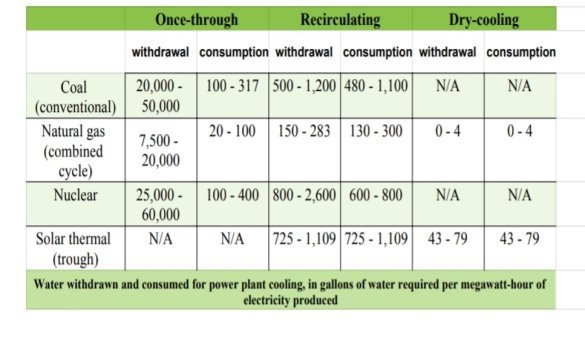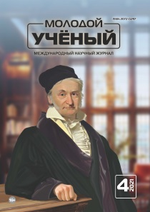The vulnerability of the power generation industry to constraints in water availability is widespread and growing, and this is increasing the pressure on power plant operators to conserve water. This report discusses where water can be conserved at power plants. It includes ways of saving water in bottom ash handling, pollution control, and cooling systems. Cooling typically accounts for the largest usage of water (where water is the coolant), and wet flue gas desulphurization is the second largest use at wet-cooled plants. If sufficient water can be economically recovered from the flue gas, then a dry-cooled power plant could become a supplier of both electricity and water. In this paper the main focus is to highlight the importance of water resources in development of energy and improvement of industrial productions.
Keywords: water-saving, power-plant, technology, energy, heating, cooling, industry.
Уязвимость электроэнергетической отрасли в отношении ограничений в доступности воды широко распространена и растет, и это усиливает давление на операторов электростанций с целью экономии воды. В этом отчете обсуждается, где можно сохранить воду на электростанциях. Он включает в себя способы экономии воды при обработке донной золы, борьбе с загрязнением и системах охлаждения. Охлаждение, как правило, объясняет наибольшее использование воды (где вода является теплоносителем), а влажная десульфурация дымовых газов является вторым по величине применением на установках с мокрым охлаждением. Если из дымовых газов можно будет экономично извлечь достаточное количество воды, то электростанция с сухим охлаждением может стать поставщиком электроэнергии и воды. В этой статье основной упор делается на то, чтобы подчеркнуть важность водных ресурсов в развитии энергетики и совершенствовании промышленных производств.
Ключевые слова: водосбережение, электростанция, технология, энергия, отопление, охлаждение, промышленность.
From the beginning of scientific revolution up until now, the demand for water resources has been rocketing in different industrial as well as energetic enterprises. We can bravely claim that the production of energy (e.g. nuclear power plants, hydroelectric power plants, thermal power plants) and many goods (e.g. paper, steel, glass, textile) are inevitably dependent on water supplies. Thirty-six countries around the world already suffer from high or extremely high water stress. Thus, we all need to understand the importance of saving water as an invaluable resource for sustaining human life. Water conservation is a job not only for water technicians, farmers, ranchers, hydrologists, foresters, city planners, and park managers; it is the responsibility of every human being.
- How is water consumed?
Apart from other industries, energy industry is responsible for the consumption of huge amount of water which needs to be managed in an integrated way in order to minimize the possibility of water shortages as well as environmental destructions. Generation of electricity require almost 560 billion Liters of water per day at the power plants burning fossil fuels for producing steam and cooling purposes. Therefore, water quantity and quality is of great importance for the efficiency of the plants. Water can leave the power plant in three ways: (1) evaporated in the flue gas, (2) as discharge streams, (3) as part of other products such as slag.

Fig. 1. The below table displays the demand of water at different power plants
- Global water saving approaches
Our mission is to develop a system that could substitute the requirement of water or to minimize water loss through sampling systems, stream losses, blowdown, and evaporation from cooling at the current systems.
Industrial facilities have a good potential for raising their water efficiency rates. Experience from around the world shows that adopting a systematic approach to water efficiency often results in reduced water consumption by 20–50 %, and up to 90 % when more advanced measures are implemented.
- Good practice guide for water intensive operation
There are a number of practices that can affect the water consumption rates at industrial enterprises. Implementing these steps leads to a more water-efficient industries.
3.1. Leak Detection - Identifying leaks and taking corrective measures for their elimination offers a good starting point for water efficiency in industry
3.2. Optimizing heating and cooling needs - Providing more cooling or heating than necessary is wasteful. Thus, one simple but often overlooked measure in cooling and heating systems involves performing the right level of heat transfer. There may also be possibilities to use the same water for multiple cooling or heating effects. These possibilities can be identified through proper energy assessments, such a pinch analysis.
3.3. Water-free systems - In certain applications, air, mineral oils, or specialty chemicals can be used to transfer heat effectively and economically, thereby eliminating the need to use water. Current commercially available systems designed to retrofit a power plant typically use a recirculating refrigerant instead of water to help transfer heat to air. The new indirect cooler design uses supercritical carbon dioxide instead of a refrigerant. Here’s how it works: Above a certain pressure and temperature, carbon dioxide becomes a supercritical fluid. The performance benefits with this design come from the amount of air needed to refresh the supercritical carbon dioxide for another round of cooling. A heat exchanger with supercritical carbon dioxide uses less air to cool water to the same temperature as a traditional dry cooler with a sub-critical refrigerant; it can also make water cooler using the same amount of air. Both impacts improve the overall energy efficiency for the cooling process.
3.4. Re-circulating systems - in single-pass heat transfer systems water or stream usually gets lost- through drainage, evaporation, or condensation. In recirculating systems heating and cooling take place in a heat exchanger designed to permit water to re-circulate in a closed system that includes either cooling towers or chillers for cooling purposes and a boiler for heating. The fraction of water that can potentially be saved by adopting re-circulating systems can be as high as 90 %.
Water used in most industrial enterprises doesn’t usually need the drinking water standards. Therefore, recycle of wastewater can bring a very positive impact in water consumption which in turn leads to more water-saving for other purposes. Installation of wastewater recirculation plants at large power and industrial plants are necessary in order to reuse the wastewater by removing contaminants such as suspended solids causing turbidity of water.
- Conclusion
From the analysis of the status and direction of development of water conservation technologies, it was found that these technologies are moving towards multidisciplinary joint implementation of corporate water management and progressively achieving scientific water management. At the same time, other unconventional sources of water are also being used to supplement water in thermal power enterprises. Through the development of wastewater treatment technologies, this study aims to achieve zero wastewater discharge. For better water management in thermal power industry in future, the principle of ‘differential treatment, meticulous management’ should be adhered to, financial support needs to be enhanced, incentive mechanism should be improved and the policies supporting water conservation technologies need to be made at the earliest. Meanwhile, water resource planning should be strengthened in the power industry, in order to guarantee regional sustainable development of water and energy.
References^
- Syed Shabudeen P. S., Water technology., 2010.
- Meng-hua Xiao, Xiu-jun Hu, Lin-lin Chu., Experimental study on water-saving and emission-reduction effects of controlled drainage technology,. 2015.
- Kali Frost, Inez Hua. Quantifying spatiotemporal impacts of the interaction of water scarcity and water use by the global semiconductor manufacturing industry. 2019.
- Anne M Carpenter, Water conservation in coal-fired power plants., IEA Clean Coal Center, February 2017.
- TheBalance.com; Conservation Efforts: Why Should We Save Water? 2017
- Return from The Importance of Saving Water to World Water Scarcity: A Little Help Can Go a Long Way
- https://www.nationalgeographic.com/news/energy/2012/08/120817-record-heat-drought-pose-problems-for-electric-power-grid/
- https://www.greenbiz.com/article/how-much-water-does-power-plant-use
- https://www.wri.org/blog/2015/08/ranking-world-s-most-water-stressed-countries-2040
- https://www.ucsusa.org/resources/water-power-plant-cooling
- US Department of Energy (DOE), 2008. Estimating Freshwater Needs to Meet Future Thermoelectric Generation Requirements. Washington, DC.
- Weiwei Shavo, Jie Feng, Jiahong Liu, Guiyu Yang, Zhiyong Yang, Jainhua Wang. Research on the status of water conservation in the thermal power industry in China. 2016







